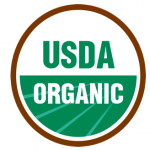Written by UConn Dietetics student Ronnie Rivera
Only 1 out of 10 are Americans are consuming the recommended amounts of fruits and vegetables each day1. The 2015-2020 Dietary Guidelines for Americans recommends adults consume ½ to 2 cups of fruit and 2-3 cups of vegetables per day2. Only 12.2% of adults meet the daily recommendation for fruit intake and only 9.3% adults eat the daily recommendation2.
 Fruits and vegetables are essential to a balanced healthy diet and can help protect against chronic diseases 3. You walk down the aisle of a supermarket and you see two versions of apples, one organic and one that is not. Both apples are shiny red, both are the same size, both taste similar. It’s often hard to tell which one is which. Both provide the same vitamins and fiber. A common misconception is that organic food is healthier because it often costs more and that is due to the expensive and specialized farming practices necessary for the produce to survive and make it to your plate.
Fruits and vegetables are essential to a balanced healthy diet and can help protect against chronic diseases 3. You walk down the aisle of a supermarket and you see two versions of apples, one organic and one that is not. Both apples are shiny red, both are the same size, both taste similar. It’s often hard to tell which one is which. Both provide the same vitamins and fiber. A common misconception is that organic food is healthier because it often costs more and that is due to the expensive and specialized farming practices necessary for the produce to survive and make it to your plate.
What does Organic mean?
Organic refers to the way farmers produce and process fruits, vegetables, grains, meat, and dairy products. At an organic  farm are federally-mandated measures that have to be in place to address soil quality, use of additives, and animal raising practices.
farm are federally-mandated measures that have to be in place to address soil quality, use of additives, and animal raising practices.
Organic farming practices include4:
- Improving the soil and water quality
- Reducing air pollution
- Providing a safe environment for animals
- Promoting self-sustaining resources
Is Organic food healthier than non-organic?
- Nutrients. Both organic and non-organic foods contain the same nutrients.
- Bacteria. Both organic and non-organic meats have the same risk of bacterial infection.
- Cadmium. A toxic metal found in the soil of organic and non-organic foods.
- Pesticides. Both organic and non-organic have risk of accumulating pesticide residue. Synthetic pesticides are used for mass production and natural pesticides are used on organic crops.
The answer is NO. Organic foods are not healthier than the non-organic version. The difference between the two is the way the foods have been farmed. For produce, whether organic or non-organic, you should thoroughly rinse before preparing and eating 5.
Organic Safety Tips6
Read Each Label Carefully. Food labels can be deceiving. The label could claim that a product is organic, but the product could also be high in sugar, fat, calories, and sodium.
- Choose a Variety of Produce. Whether you eat all organic or non-organic foods select and consume a variety. That will give you many different nutrients and reduce the likelihood of being exposed to a single pesticide.
- Protective Shield. Fruits or vegetables that require peeling like an orange or an avocado don’t need to be organic because their outer layer acts as a barrier to any bacteria, and the peel housing pesticide residue is being thrown away. Foods like kale, spinach and strawberries you may want to consider buying organic. The Environmental Working Group publishes a yearly “Dirty Dozen” which is a “shoppers’ guide to pesticides in produce https://www.ewg.org/foodnews/dirty-dozen.php
- Wash Fruits and Vegetables under Water before Eating. By washing these foods you are removing dirt, bacteria, and traces of pesticides from the surface.
- Cook the Bad Away. Cooking food to a temperature of 165 degrees Fahrenheit or more will start to kill any bacteria present.
Ginger Coconut Summer Salad With Organic Chicken

Ingredients
- 6-8 cups mixed greens (arugula, mache, frisee)
- 1 cooked chicken breast, thinly sliced
- 1/2 large mango, sliced thinly
- 1/4 red onion, thinly sliced
- 1/2 inch fresh ginger root, peeled and minced
- 1 tbsp unsweetened coconut flakes
- 2 tbsp lemon juice
- 2 tbsp lemon zest
- 2 tbsp extra virgin olive oil
- dash of sea salt, to tastedash and ground black pepper, to taste
Directions
- Arrange greens on serving plate or bowl. Scatter chicken, mango and onion slices on top.
- In a small bowl whisk together ginger, coconut flakes, lemon juice, lemon zest, oil, salt and pepper. Drizzle over salad and serve.
Citations:
- Lee-Kwan SH, Moore LV, Blanck HM, et al. Disparities in state-specific adult fruit and vegetable consumption- United States, 2015. MMWR.2017;66:1241-1247.
- US Department of Health and Human Services and US Department of Agriculture 2015-2020 Dietary Guidelines for Americans. 8th December 2015.
- Centers for Disease Control and Prevention. State Indicator Report on Fruits and Vegetables, 2018. Atlanta, GA: Centers for Disease Control and Prevention, U.S. Department of Health and Human Services; 2018.
- Introduction to organic practices. U.S. Department of Agriculture.
- https://www.ams.usda.gov/publications/content/introduction-organic-practices. Accessed 2021.Smith-Spangler C, et al. Are organic foods safer or healthier than conventional alternatives?: A systematic review. Annals of Internal Medicine. 2012;157:348. Accessed 2021.
- Pesticides and food: Healthy, sensible food practices. U.S. Environmental Protection Agency. https://www.epa.gov/safepestcontrol/pesticides-and-food-healthy-sensible-food-practices Accessed 2021

This material is funded by UDSA’s Supplemental Nutrition Assistance Program (SNAP).
This institution is an equal opportunity employer.